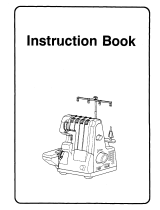
5
TABLE OF CONTENTS
PREPARATION
Names of Parts ............................................................................................................................... 8
Standard Accessories ................................................................................................................... 10
Connecting the Machine to the Power Supply......................................................................................12
Controlling Sewing Speed............................................................................................................. 12
How to Turn the Handwheel ......................................................................................................... 14
Opening and Closing the Side Cover ........................................................................................... 14
Opening and Closing the Looper Cover ....................................................................................... 14
Raising or Lowering the Presser Foot .......................................................................................... 16
Removing the Presser Foot .......................................................................................................... 16
Attaching the Presser Foot ........................................................................................................... 16
Adjustment of Foot Pressure ........................................................................................................ 16
The Position of Thread Guide Bar ................................................................................................18
Attaching the Spool Holder Cap and Net.............................................................................................. 18
Changing Needles ........................................................................................................................ 20
Stitch Definition ............................................................................................................................. 22
Adjustment of Stitch Length .......................................................................................................... 26
Adjustment of Differential Feed Ratio ...........................................................................................26
Adjustment of Needle Plate Setting Knob..................................................................................... 28
To Deactivate the Upper Knife...................................................................................................... 30
To Activate the Upper Knife .......................................................................................................... 30
Adjustment of Cutting Width ......................................................................................................... 32
Threading the Machine ................................................................................................................. 34
Threading the Lower Looper......................................................................................................... 38
Threading the Upper Looper......................................................................................................... 44
Threading the Needle on the Right ...............................................................................................48
Threading the Needle with the Needle Threader.......................................................................... 52
Threading the Needle on the Left ................................................................................................. 54
TEST STITCHING
Starting Sewing ............................................................................................................................. 58
Finishing Sewing ........................................................................................................................... 58
Sewing Continuously .................................................................................................................... 58
How to Use Guide Lines ............................................................................................................... 58
Securing Ends............................................................................................................................... 60
Thread Tension (4 threads) .......................................................................................................... 62
3-Thread Serging .......................................................................................................................... 66
Thread Tension (3 threads) .......................................................................................................... 68
Thread Tension for Rolled Hemming ............................................................................................ 70
CARE OF YOUR MACHINE
Replacing the Upper Knife ............................................................................................................ 74
Cleaning Upper Knife Area ........................................................................................................... 74
Replacing the Light Bulb ............................................................................................................... 76
Cleaning the Feed Dog ................................................................................................................. 76
Oiling the Machine ........................................................................................................................ 78
Carrying the Machine .................................................................................................................... 78
Troubleshooting ............................................................................................................................ 80




















